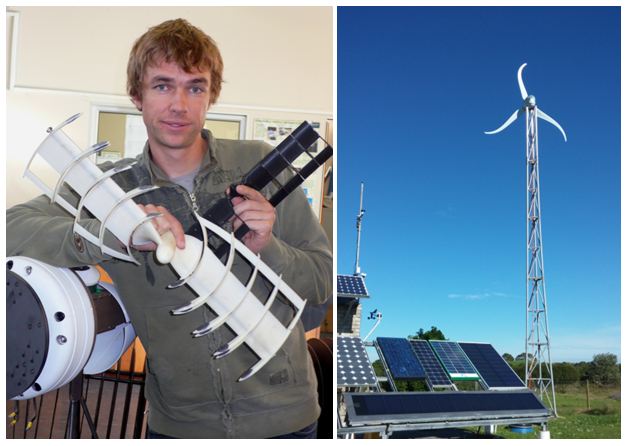Researchers in the university’s Centre for Energy Research (CER) are now measuring how the yield of wind-produced electricity compares to the yield of sun energy.
But they all agree that both are essential for optimal green energy results. “Because the wind doesn’t blow every day and the sun doesn’t shine every day, renewable energy systems should be a hybrid of wind and solar to maximize energy yield,” said mechanical engineering Associate Professor Russell Phillips.
The new R45000 turbine, which was manufactured in the United States and produces up to 2.8kW of electricity, is “state of the art in the way it controls itself”, said Phillips.
“Intelligence is built into the turbine. It’s essentially a ‘plug and play’ – you plug it in and it takes control. Through a wireless link, it downloads data to a PC.” It even emails daily data reports to the physics and mechanical engineering researchers monitoring its activity.
As part of his research, doctoral student Sean Poole (pictured below) is carefully monitoring how the new turbine does its job, and how it can be improved.
“There is a lot of maths involved in terms of how you control the turbine and extract energy, and how you load it electronically,” explained Phillips. In simple terms, it has to be electronically controlled to “change gears” depending on the speed of the wind it faces. If this is performed optimally, the daily energy yield can be maximized.”
One of the things Poole will be looking at is blade design. The university has patented a unique segmented blade turbine, designed by Phillips, to maximize daily energy yield in gusty, below-the-treeline urban conditions – as opposed to the high, open plains where larger traditional wind turbines are used. Small models of his design have successfully been tested in wind tunnels and Poole is currently working on full-size models for further testing in the field. “Each segmented section in the blade can adapt and rotate freely, changing its angle very quickly as the wind changes,” said Poole. This enables the turbine to adopt the perfect shape for each and every wind speed, creating a greater energy yield.
Poole and Phillips hope that their design will one day be used in cities, and tied directly to the grid or to whatever energy-requiring activity it might be needed for.
Along with blade design, Poole will also monitor the new NMMU turbine for maximum power point tracking, which is essentially controlling the turbine as the wind changes for maximum yield, and an advanced “yaw mechanism”, which is how the turbine faces into the wind.
The university will soon be adding another turbine to its grid – a Port Elizabeth-built and designed Kestrel – which has been donated for research. “NMMU has a close relationship with Kestrel,” said Phillips.
Phillips said it was ultimately hoped that the university would run completely on renewable energy. “We have all this roof space – every rooftop should be full of photovoltaic (solar) panels … It is feasible but it’s a long way off.”
